Key points about Highest Common Factor and Lowest Common Multiple

To find the Highest Common Factor (HCF)The greatest factor that will divide into the selected numbers. 10 is the highest common factor of 30 and 20. and the Lowest Common Multiple (LCM)The lowest multiple that is common to two or more numbers. The LCM of 15 and 12 is 60 because it is the lowest value in both of their multiplication tables. Also known as the Least Common Multiple. of two or more numbers:
List factorA number or variable that divides exactly into a term. and multipleAn integer that is in the multiplication table of a specific number. For example, 20 is a multiple of ten because 20 is in the ten times table..
Express the numbers as a product of prime factorsThe factors of 12 are 1, 2, 3, 4, 6 and 12. The prime factors of 12 are 2 and 3. 12 may be expressed as a product of its prime factors: 12 = 2 × 2 × 3. - this is more efficient for large numbers.
Use a Venn diagramA visual diagram with overlapping circles, used to show the relationships between two or more different groups or sets., populated with the of the numbers.
Refresh your knowledge with these guides on factor trees and writing numbers as a product of prime factors.
Check your understanding
Highest Common Factor (HCF) and Lowest Common Multiple (LCM)
Find the Highest Common Factor (HCF)The greatest factor that will divide into the selected numbers. 10 is the highest common factor of 30 and 20. by doing the following:
List the factors of each number.
Compare the lists to find the greatest number common to both. This is the HCF.
Find the Lowest Common Multiple (LCM)The lowest multiple that is common to two or more numbers. The LCM of 15 and 12 is 60 because it is the lowest value in both of their multiplication tables. Also known as the Least Common Multiple. by doing the following:
List consecutiveIntegers which follow on from each other continuously without gaps. For example, 1, 2, 3, 4, 5 and so on are consecutive numbers. 2, 4, 6, 8 are consecutive even numbers. multiples for each number.
Find the first multiple to occur in every list. This is the LCM.
Following the working out below
GCSE exam-style questions

- Find the Highest Common Factor of 28 and 42.
The Highest Common Factor of 28 and 42 is 14.
List the factors of each number:
The factors of 28 are 1, 2, 4, 7, 14, 28.
The factors of 42 are 1, 2, 3, 6, 7, 14, 21, 42.
Compare the lists to find the highest number common to both.
- Find the Lowest Common Multiple of 28 and 42.
The Lowest Common Multiple of 28 and 42 is 84.
List consecutive multiples for each number:
The multiples of 28 are 28, 56, 84, 112, 140 …
The factors of 42 are 42, 84 …
The first multiple common to both lists is the LCM (84).
HCF and LCM using prime factors
- Highest Common Factor:
Draw for each number.
Write each number as a product of its .
- It can be easier not to use index (plural indices)Positioned above and to the right of a number. It is an abbreviation of repeated multiplication, eg 7³ means 7 × 7 × 7. An index may be positive, negative, zero or fractional. Indices are also referred to as powers or exponents. form and to write it out in full instead.
Identify the common prime factors in each product of prime factors.
Multiply the common prime factors to find the HCF.
- Lowest Common Multiple:
Draw factor trees for each number.
Write each number as a product of prime factorsThe factors of 12 are 1, 2, 3, 4, 6 and 12. The prime factors of 12 are 2 and 3. 12 may be expressed as a product of its prime factors: 12 = 2 × 2 × 3..
Identify the prime factors common to each product.
- The prime factors that are not common to each product are unique for that number.
Find the LCM by multiplying the common factors by the unique factors of one number and the unique factors of the other number.
Following the working out below
GCSE exam-style questions
- Find the Highest Common Factor of 120 and 63.
120 = 2³ × 3 × 5 and 63 = 3² × 7.
The HCF of 120 and 63 is 3.
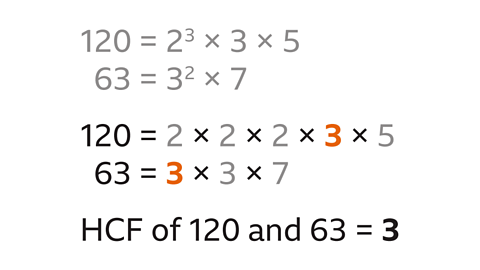
Write each product of prime factors without using index notation:
120 = 2 × 2 × 2 × 3 × 5
63 = 3 × 3 × 7
The only common prime factor is 3, so 3 is the HCF of 120 and 63.
- Find the Lowest Common Multiple of 120 and 63.
120 = 2³ × 3 × 5 and 63 = 3² × 7.
2520 is the Lowest Common Multiple of 120 and 63.

Write each product fully without index notation:
120 = 2 × 2 × 2 × 3 × 5
63 = 3 × 3 × 7
The only prime factor common to each product is 3.
The prime factors unique to 120 are 2, 2, 2 and 5.
The prime factors unique to 63 are 3 and 7.
Multiply the common factors by the unique factors:
- 3 × 2 × 2 × 2 × 5 × 3 × 7 = 2520
How to use Venn diagrams
Write each number as a product of prime factorsThe factors of 12 are 1, 2, 3, 4, 6 and 12. The prime factors of 12 are 2 and 3. 12 may be expressed as a product of its prime factors: 12 = 2 × 2 × 3. without using index (plural indices)Positioned above and to the right of a number. It is an abbreviation of repeated multiplication, eg 7³ means 7 × 7 × 7. An index may be positive, negative, zero or fractional. Indices are also referred to as powers or exponents..
Create a Venn diagram:
Draw a circle for each number.
Place the factors that are common to both numbers in the of the circles.
Place the remaining for the first number in its circle.
Place the remaining prime factors for the second number in its circle, and so on.
Check that each circle contains the full prime factorisation for each number.
Find the HCF of the numbers by multiplying the numbers in the intersection.
Find the LCM of the numbers by multiplying the numbers in the circles in the Venn diagram.
Following the working out below
GCSE exam-style questions
- The Venn diagram shows the prime factors of 64 and 100.
Use the Venn diagram to work out the Highest Common Factor and the Lowest Common Multiple of 64 and 100.
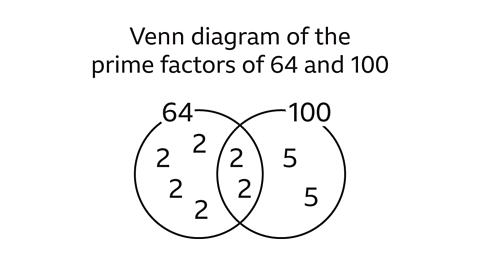
The HCF of 64 and 100 is 4.
The LCM of 64 and 100 is 1600.
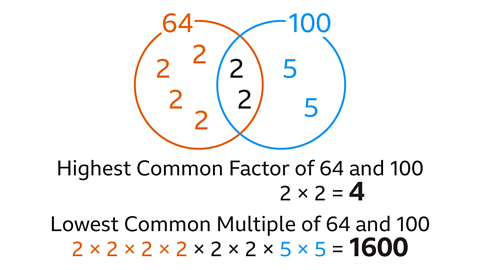
The Highest Common Factor is the product of the prime factors in the intersection of the Venn diagram:
2 × 2 = 4
The HCF is 4.
The Lowest Common Multiple is the product of all the prime factors in the circles, those unique to 64 (2, 2, 2, 2), those in the intersection (2, 2) and those unique to 100 (5, 5).
2 × 2 × 2 × 2 × 2 × 2 × 5 × 5 = 1600
The LCM is 1600.
- Complete the Venn diagram of prime factors and find the Highest Common Factor and Lowest Common Multiple of 242 and 594.
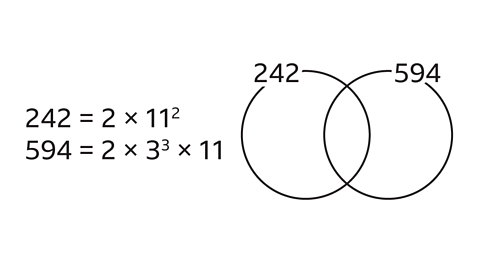
The HCF of 242 and 594 is 22.
The LCM of 242 and 594 is 6534.
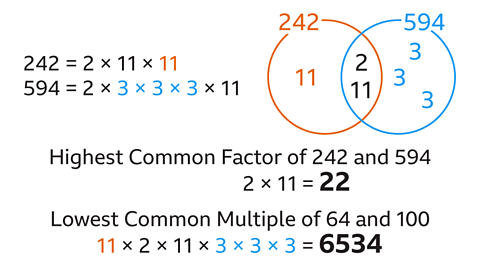
Write each product of prime factors without index notation:
242 = 2 × 11 × 11
594 = 2 × 3 × 3 × 3 × 11
The common prime factors (2 and 11) are placed in the intersection (overlap) of the Venn diagram.
The prime factor unique to 242 (11) is placed in the 242 circle but not in the intersection.
The prime factors unique to 594 (3, 3 and 3) are placed in the 594 circle but not in the intersection.
The Highest Common Factor is the product of the prime factors in the intersection of the Venn diagram:
- 2 × 11 = 22.
The Lowest Common Multiple is the product of all the prime factors in the circles, those unique to 242 (11), those in the intersection (2, 11) and those unique to 594 (3, 3, 3):
- 11 × 2 × 11 × 3 × 3 × 3 = 6534
HCF and LCM - interactive activity
This interactive activity will help you understand how to calculate the HCF and LCM of a pair of numbers by placing their prime factors in a Venn diagram.
Quiz - HCF and LCM
Practise what you've learned about Highest Common Factor and Lowest Common Multiple with this quiz. The quiz questions change each time you play, so keep testing your knowledge.
Now you've revised Highest Common Factor and Lowest Common Multiple, why not look at this guide on decimals?
More on Number
Find out more by working through a topic
- count12 of 15

- count13 of 15

- count14 of 15

- count15 of 15
